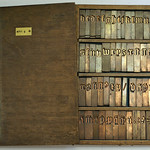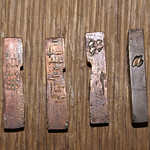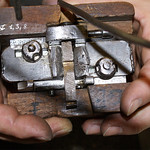As described in the introduction, the underlying hypothesis for this research is that Gutenberg and his colleagues developed a standardized and unitized system for the production of Textura type, and that this system was extrapolated to roman (and later italic) type. Humanistic handwriting was thus modeled into predetermined standardized proportions.

LeMo-based templates with a Pilot Parallel Pen 6 mm Pilot Parallel Pen
In line with my illustrious predecessor and tutor at the kabk, Gerrit Noordzij, I consider writing a good starting point for exploring matters such as construction, contrast sort, contrast flow, and contrast. However, translating handwriting into type is in principle not a very straightforward process. Although they are trained to work directly from their own writings, students often begin to define grids before they draw letters. And usually they look at existing typefaces for the ‘correct’ proportions. Obviously, patterning is a requirement for designing type and it is difficult to distill these patterns from handwriting. Therefore, could it be possible that type also find its origin in patterning intrinsically related and/or artificially added to writing, and that the latter even influenced writing after the invention of movable type?

From Poggio’s model to Jenson’s via Noordzij’s Humanistic hand
There seems to be no Humanistic handwriting predating movable type that shows such a clear standardization as roman type. My measurements of incunabula seem to prove that character widths were standardized during the Renaissance. The written Textura Quadrata made it relatively easy for Gutenberg and his peers to standardize and systematize their movable Gothic type. When this was achieved, it was obvious to apply the same system to the new roman type (and decades later on italic type). The clear morphological relationship between Textura and Humanistic minuscule made this possible.

There is an intrinsic standardization of character widths in the Humanistic minuscule
The shared underlying structure of Textura Quadrata and Humanistic minuscule allowed for an organic standardization of the handwritten models. This standardization was always there, but it was not necessary to record it strictly before movable type was produced. Standardized widths were a natural extension of the handwritten model, although the positioning of side bearings were not. After all, a calligrapher does not mind where the space that belongs to a character starts or end. This standardization of character widths based on the intrinsic systematization of the underlying written model is recorded in the dtl LetterModeller (LeMo) application.

Pattern created with the geometric letter model
Nowadays it is quite common to first design characters and then apply side bearings. It is quite plausible that during the early days of typography the proportions and widths of the characters were defined first and subsequently the details were adapted to the widths.

Template formed by the geometrically based pattern
As mentioned, the step from handwriting to type design is not simple, even for an experienced calligrapher. I have some experience with that: I set up a calligraphy course for the Dutch television and wrote an accompanying book end of the 1980s. Noordzij was very positive about it in Letterletter 12 from June 1991: ‘Frank Blokland has succeeded in bringing the literature on calligraphy on a higher level; his book makes better reading and is a more reliable guide than any other book on the subject.’
The question is, how to combine the outcomes of my measurements with calligraphy in type-design education. Well, one can make a template with LeMo, such as this one for a Pilot Parallel Pen 6 mm. In the case of a translation over 30 degrees, the stem thickness is pen-width × sin 60º = 0.87. The x-height here is five times the stem thickness; approximating what I measured in Jenson’s type (which is actually slightly bolder).

Pattern traced with a broad nib
The template can then be used to trace with a broad nib (additionally, one can try adding some subtle details). The outcome can be auto-traced and converted into a font. As mentioned, spacing is an intrinsic part of the system, so the letters should automatically form words.

Auto-traced letters with unfilled outlines
This basis can be used for further formalization and refinement. It is, of course, not necessary to standardize the character widths for the production of digital type. After all, current technology is very versatile and flexible. This is, however, clearly different from the technical constraints during the Renaissance, and therefore from what was required in the practice of the archetypal punchcutter.

Text typeset using the digitized written letters

Written pattern transferred into digital roman type
The image above shows the transformation of the digitized handwritten letters into formal variants, using the original LeMo-based standardization. The stem interval has been maintained by mainly adjusting the length of the serifs to achieve a balance in the white space. In this way, for example, the /n becomes measurably centered in its character width: this maintains equal distances between all stems. It is likely that for this reason Jenson applied asymmetrical serifs to, for example, the /n. The /o looks circular, but it is an ellipse (and it is, of course, as wide as its handwritten origin to maintain the character width).

Text typeset with roman type that finds it origin in systematized writing
For typesetting foundry type –especially for justification of lines– it is useful if the widths of characters and spaces are defined in the same units. The simplest system has been applied here in the examples, using the stem-thickness as basic value. The original spacing was rounded to the grid.

The template-based roman type converted to a simple grid system
The original character proportions are retained here. The fitting becomes slightly tighter, but the word spaces become slightly wider in this case (rounded to three units). So far, the character relationships and their widths have been generated parametrically, that is, not optically, throughout the process.

Text typeset with the grid-fitted roman type
The grid can then be doubled for refinement.

Refinement of the grid
And this process can be repeated.

Further refinement of the grid
A more refined grid also makes it possible to redefine the proportions of certain letters on it. Here one enters the world of cadencing, so that is a different story.




